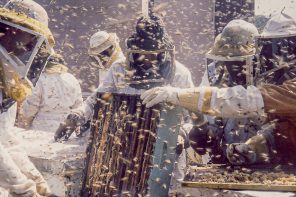I’ve mentioned that almonds are one of California’s biggest crops. Just so you know, here’s some more info that supports the fact that the beekeeping industry should be paying more attention to this tree.
Last year there were 740,000 bearing acres of almonds, but more importantly, there were 85,000 acres of non-bearing acres. That translates to 1,480,000 colonies needed last year, and another 170,000 needed in a couple of years from now. Total…at least, at least mind you (because I don’t have the figures yet for how many acres are being planted this year) 1,650,000 colonies needed to pollinate this crop. That’s between 65 – 70% of all the commercial colonies in the U.S. Just so you know.
This year there will be 1,950,000,000 pounds of almonds produced at about $2.00 a pound… that’s $3.9 billion farm gate value. That comes to about $3,836 per acre…and the cost of pollination is right about $150 per acre…about 4% of the take home pay. California dominates almond production on a global scale, producing 80.1% of all the almonds produced. Interestingly, per capita consumption of almonds in this country is greater than honey…honey is just a tad over a pound…almonds 1.57 pounds per person, per year.
Kern County, where Bakersfield is located, is the largest almond producing county in the state, and produces the most almonds…but receives the least amount of almond country rain in a year…on average 5.5 inches. They produce 403.5 million pounds of almonds there each year…followed by Fresno country at 344.5 million pounds. Everybody else pales in comparison.
Almond planting is slowing however. Water is a key ingredient in that decision, but so is available land…or land that’s good for almonds that is. The market certainly isn’t slowing, and demand continues to outpace supply. Almond growers are in a fine spot…even though production costs continue to climb, the price they can sell them for climbs more…what a sweet place to be.
Almond growers, like our honey packers, have a marketing order…the California Almond Board. Membership is mandatory, but they do great things with their money. The cost of doing business is that every grower pays $0.03/lb to the Board for its operation. Last year that came to about $52 million for marketing. 39% of that is spent on North American marketing, 31% on international marketing, 17% on administration, 10% on research, 2% on industry relations and 1% on regulatory affairs. Of the research dollars spent, fully 10% is spent on pollination…which, out of $52 million is a chunk of change.








